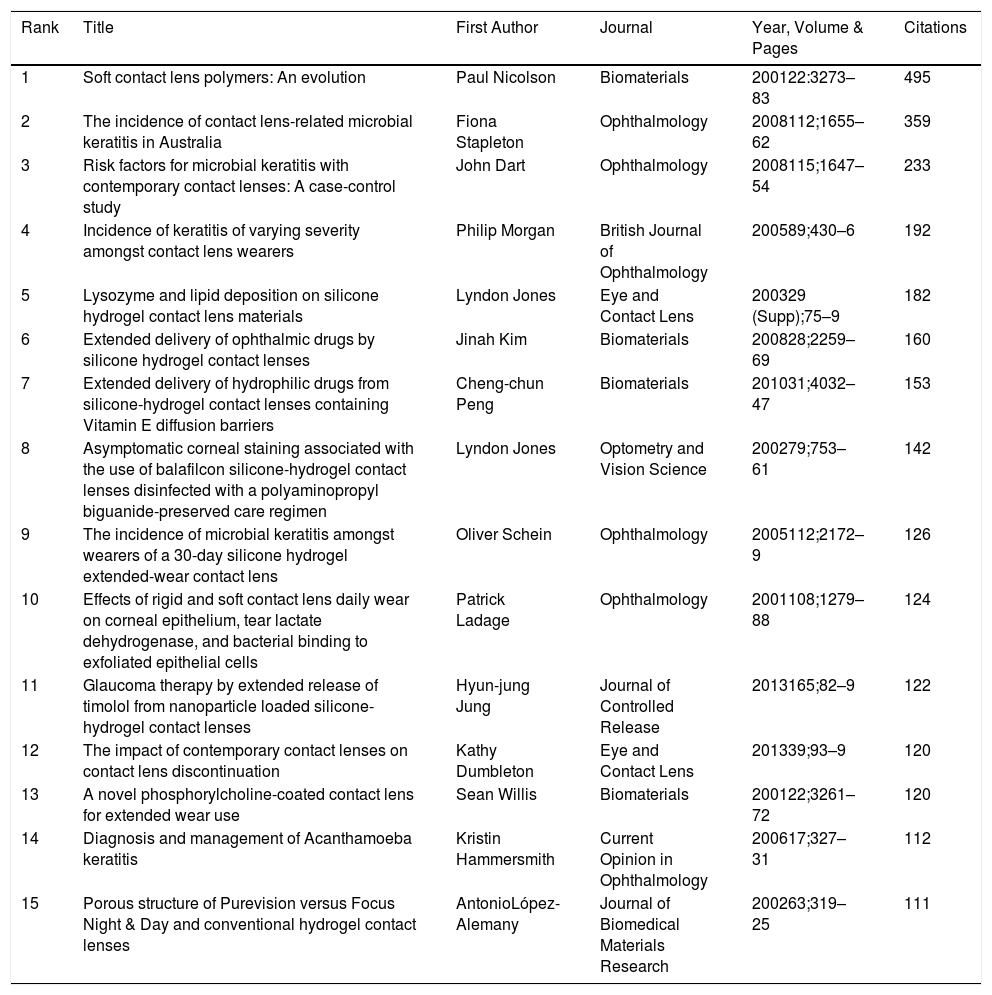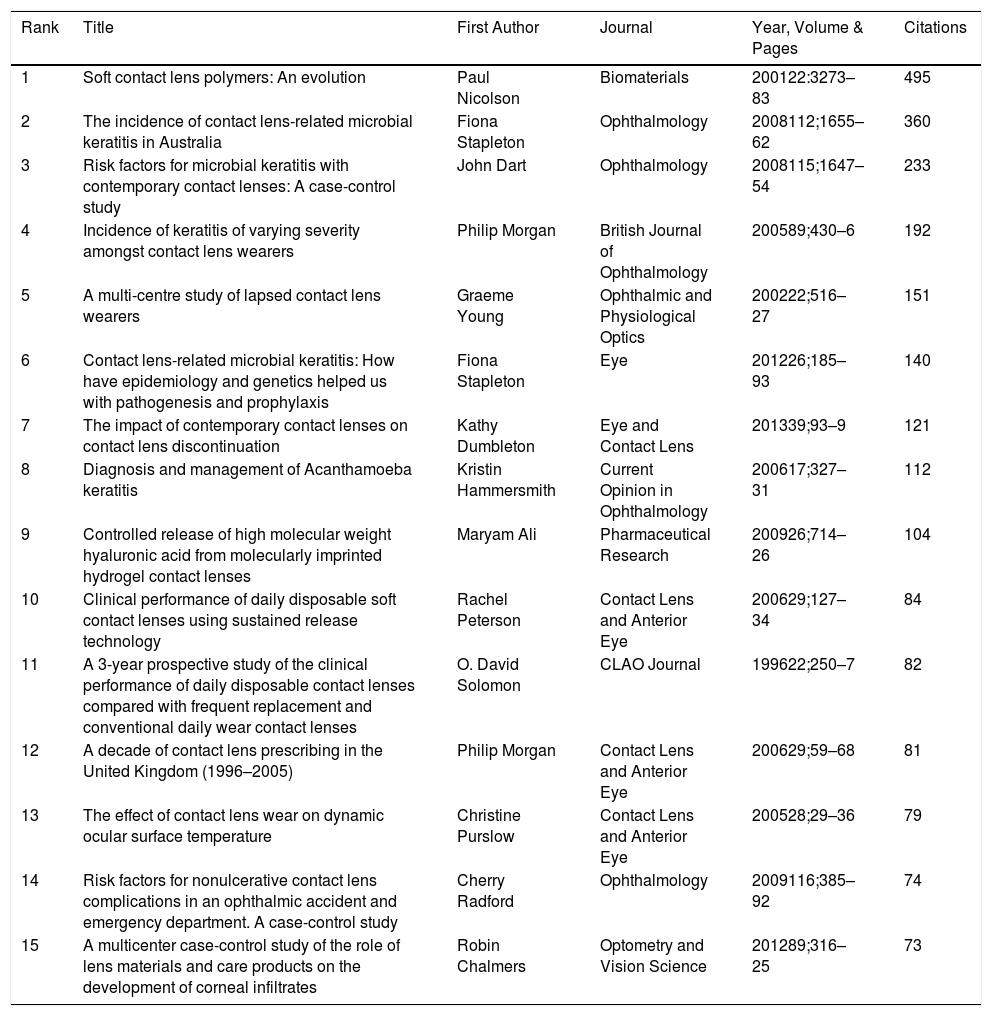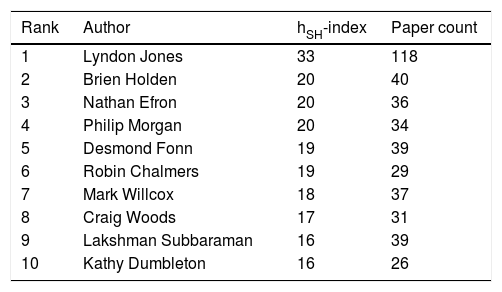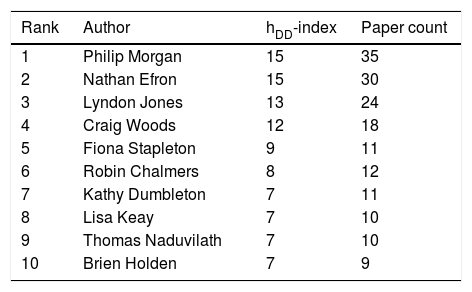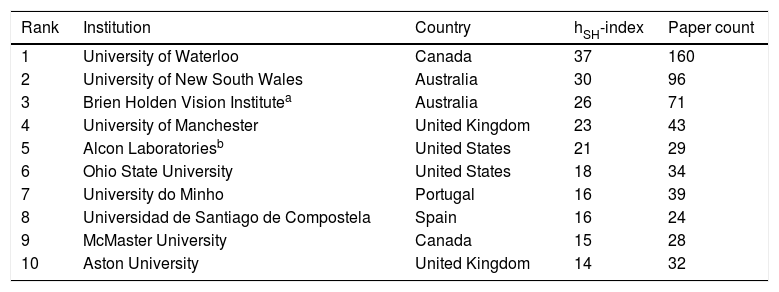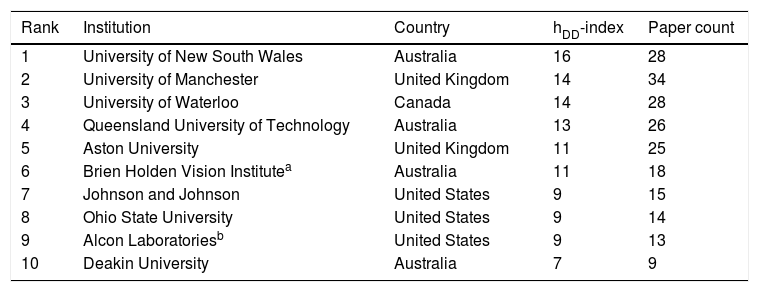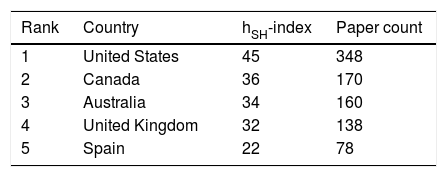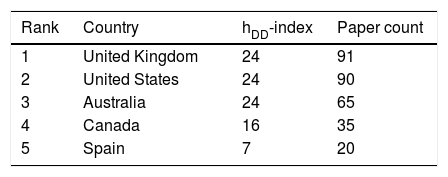Publication metrics are derived for the fields of silicone hydrogel (SH) and daily disposable (DD) contact lenses.
MethodsA search of the Scopus database for papers in the fields of SH and DD contact lenses found 979 SH and 291 DD papers. Subject-specific h-indices for SH lenses (hSH-index) and DD lenses (hDD-index) were derived, in relation to five categories – authors, institutions, countries and journals – to serve as measures of impact. A short list of the most impactful entities was generated for each of the above five categories in the SH and DD fields.
ResultsA paper entitled “Soft contact lens polymers: An evolution” by Nicholson and Vogt was the most highly cited article (495 citations) in both SH and DD fields. The most impactful entities for the SH and DD fields were: authors – Lyndon Jones (hSH = 33) and Philip Morgan (hDD = 15); institutions – the University of Waterloo (hSH = 37) and the University of New South Wales (hDD = 15); countries – the United States (hSH = 45) and the United Kingdom (hDD = 24); and journals – Optometry and Vision Science (hSH = 33) and Contact Lens and Anterior Eye (hDD = 17). Overall, the SH field (hSH = 64) is far more impactful than the DD field (hDD = 34).
ConclusionsImpactful papers, authors, institutions, countries and journals in the SH and DD fields are identified. Optometry is revealed as the leading profession in relation to SH and DD publications.
The development of silicone hydrogel materials and daily disposability represents two of the most significant advancements in the field of contact lenses over the past 30 years. Silicone hydrogel materials have enabled soft lenses, across a wide range of powers, to be capable of delivering near-natural levels of oxygenation to the cornea during both open- and closed-eye wear,1-3 thus minimising hypoxic effects of lens wear on the anterior eye.4 This material type has been extremely successful, to the extent that it now accounts for about 72% of soft contact lenses prescribed world-wide.5
Daily disposable lenses are a product of significant advances in contact lens manufacturing, resulting in far lower costs per unit lens, making daily disposability economically viable. Daily replacement of contact lenses offers greater convenience for lens wearers,6 enhanced compliance,7 cost efficiency,8 minimal environmental impact9 and ocular health benefits.10 Approximately 46% of soft contact lenses prescribed globally are daily disposable lenses.5
To characterise the literature underpinning these important contemporary developments, a bibliometric analysis was undertaken to determine the most widely cited papers and most prolific authors, institutions, countries and journals relating to the fields of silicone hydrogel and daily disposable contact lenses. The metrics characterising these two topics are also compared and contrasted.
Materials and methodsTwo independent bibliometric analyses were conducted to evaluate the literature concerning silicone hydrogel and daily disposable contact lenses. The search protocol used here was undertaken using the Scopus database (Elsevier). The following search terms were derived to ensure (a) high sensitivity, including a wide capture of articles with either silicone hydrogel or daily disposable contact lenses as the primary themes, and (b) high specificity, so as to rule out irrelevant or peripherally related articles.
The search term for silicone hydrogel contact lenses was as follows: TITLE-ABS-Key(“silicone hydrogel*” or “siloxane hydrogel*”) AND TITLE-ABS-KEY(“contact lens*”) AND (LIMIT-TO(LANGUAGE, “English")) AND (LIMIT-TO(SRCTYPE, "j")) AND (EXCLUDE(PUBYEAR, 2021))
The search term for daily disposable contact lenses was as follows: TITLE-ABS("daily disposable*" OR "single use lens" OR "daily replacement" OR "one use" OR "1 day disposable" OR “single use disposable”) AND TITLE-ABS-KEY("contact lens*") AND NOT TITLE-ABS("Sclera*") AND NOT TITLE(“glucose”) AND NOT PUBYEAR BEF 1992 AND (LIMIT-TO(SRCTYPE, "j")) AND (LIMIT-TO(LANGUAGE,"English"))
The searches for silicone hydrogel and daily disposable lenses were conducted on December 17 and 23, 2020, revealing 979 and 291 articles, respectively. The top 15 most cited papers for each lens type could be determined by listing the papers in rank order of number of citations.
Each of these two lists of papers also served as a database from which targeted analyses were conducted to determine impact in respect of the following four additional categories – authors, institutions, countries and journals – using a methodology developed by the present authors.10 The first step was to generate a list of the top 25 in each of these categories by paper count, e.g. for the category ‘authors’, the author who had published the most papers in each of the two pools of 979 and 291 papers was listed first, and so on, down to 25 authors in each list.
Quality was assessed using the concept of h-index11 – a single metric that combines productivity (number of papers) and impact (number of citations). This metric can be applied to any category; for example, the h-index of an author is defined as the maximum value of h, such that the author has published h papers that have each been cited at least h times. To continue with the example of ‘authors’ – a subject-specific silicone hydrogel contact lens h-index (the “hSH-index”) and daily disposable contact lens h-index (the “hDD-index”) were derived for each author, to serve as a measure of the impact that each author has had in the field.
The hSH-index and hDD-index of a given author were determined by sorting the subset of publications for that author by rank order of citations (from highest to lowest) and working down the list, starting with the paper that had the highest number of citations, to determine the first paper with a paper rank number that was greater than its number of citations. The hSH-index and hDD-index for that author was identified as the number of the entry above the identified paper. This was repeated for each of the 25 most prolific authors; the top 10 were then identified and ranked in order of hSH-index and hDD-index, with tied ranks broken in favour of a higher number of published papers. The same approach was applied for the analysis of institutions, countries and journals, with some differences in the number of top entities listed in each category.
Results and discussionTimeline and overall citation metrics of publicationsFig. 1 shows the number of papers published each year in the fields of silicone hydrogel contact lenses and daily disposable contact lenses between 1990 and 2020. It is clear that, overall, there has been greater academic interest in the field of silicone hydrogel contact lenses.
As can be seen from Fig. 1, six papers were published on silicone hydrogel contact lenses during the developmental phase in the late 1990s; there was then a sharp increase in the volume of papers, peaking at 76 papers in 2013, and a declining number thereafter. These works have been cited 20,022 times; however, 10.4% of these papers remain uncited. The combined body of work has a hSH-index of 64.
Daily disposable lensesFig. 1 reveals that the literature on daily disposable contact lenses commenced with five papers published in 1994; this increased to 30 papers in 2020. These papers have been cited 5832 times, with 15.3% of articles uncited. The combined body of work has a hDD--index of 34.
Highly cited papersSilicone hydrogel lensesTable 1 lists the top 15 silicone hydrogel contact lens-related papers, ranked by their numbers of citations. Of these, six discuss contact lens-associated keratitis and microbial adherence to epithelial cells (#2, 3, 4, 9, 10 and 14); four report on contact lens deposition and drug release (#5, 6, 7 and 11); three discuss lens polymer structure (#1, 13 and 15); one describes solution-induced corneal staining (#8); and one considers discontinuation from lens wear (#12).
Top 15 most highly cited silicone hydrogel-related articles ranked by number of citations.
The top 15 daily disposable contact lens-related papers ranked by their numbers of citations are shown in Table 2. Of these, six discuss contact lens-associated infiltrates and keratitis (#2, #3, #4, #6, #8 and #15); two consider lapsed wearers (#5 and #7); two report on contact lens drug release (#9 and #10); two describe non-ulcerative clinical findings relating to lens wear (#11 and #14); and single papers cover advances in contact lens polymers (#1), trends in prescribing contact lenses (#12) and dynamic ocular surface temperature during lens wear.
Top 15 most highly cited daily disposable-related articles ranked by number of citations.
Six of the top 15 papers in Table 1 (#1, #2, #3, #4, #12 and #14) also appear in Table 2, at ranks (#1, #2, #3, #4, #7 and #8) respectively. The paper ranked #1 in both Tables 1 and 2 is entitled “Soft contact lens polymers: An evolution” by Nicholson and Vogt, that has been cited 495 times. This review paper details the polymeric properties of silicone hydrogel contact lens materials and materials from which daily disposable contact lenses can be fabricated.
Papers #2, #3 and #4 in Tables 1 and 2 (the same papers), as well as the paper ranked #14 in Table 1 and #8 in Table 2, relate to the risk of microbial keratitis of both silicone hydrogel and daily disposable contact lenses, which is a critical consideration when evaluating the safety of these lens types. The paper ranked #12 and #7 in Tables 1 and 2, respectively, considers the impact of silicone hydrogel and daily disposable contact lenses on discontinuation from lens wear, another key consideration in evaluating the success of various contact lens types.
The reason why the papers ranked #2 and #7 in Table 2 each have one more citation than the same paper listed in Table 1 (at ranks #2 and #12, respectively) is because, as stated in the Methods, the analysis of daily disposable papers was conducted six days after the analysis of silicone hydrogel papers, thus allowing more time for additional daily disposable lens citations to accrue.
Most impactful authorsSilicone hydrogel lensesTable 3 shows the 10 most impactful authors in the field of silicone hydrogel contact lenses, ranked by hSH-index. In this table, the hSH-indices of the authors range from 16 to 33. Lyndon Jones is the most impactful and prolific author by a wide margin, with a hSH-index of 33 and having published 118 papers.
Of the 10 most impactful authors, 9 are optometrists; Mark Willcox (rank #7) is a microbiologist. Two of the top 10 are female – Robin Chalmers and Kathy Dumbleton.
Daily disposable lensesThe 10 most impactful authors in the field of daily disposable lenses, ranked by hDD-index are presented in Table 4. In this table, the hDD-indices of the authors range from 7 to 15. Philip Morgan and Nathan Efron are the most impactful authors, each having a hDD-index of 15. Philip Morgan is also the most prolific author, with 35 papers.
Nine of the 10 most impactful authors are optometrists; Thomas Naduvilath at rank #9 is a biostatistician. Four of the top 10 are female – Fiona Stapleton, Robin Chalmers, Kathy Dumbleton and Lisa Keay.
Author overlapGiven that authors with a specialist interest in contact lenses often publish on a multitude of topics within that broad subject area, it is unsurprising that seven of the top authors featured in Table 3 (those ranked #1, #2, #3, #4, #6, #8 and #9) also feature in Table 4, albeit in a different rank order (the corresponding ranks in Table 2 being #3, #10, #2, #1, #6, #4 and #7).
Leading institutionsSilicone hydrogel lensesTable 5 lists the 10 most impactful institutions in the field of silicone hydrogel contact lenses ranked by hSH-index. In this table, the hSH-indices of the leading institutions range from 14 to 37. These institutions are based in Australia (2), Canada (2), Portugal (1), Spain (1), the United Kingdom (2) and the United States (2).
Top 10 institutions of silicone hydrogel-related articles, ranked by institution hSH-index.
| Rank | Institution | Country | hSH-index | Paper count |
|---|---|---|---|---|
| 1 | University of Waterloo | Canada | 37 | 160 |
| 2 | University of New South Wales | Australia | 30 | 96 |
| 3 | Brien Holden Vision Institutea | Australia | 26 | 71 |
| 4 | University of Manchester | United Kingdom | 23 | 43 |
| 5 | Alcon Laboratoriesb | United States | 21 | 29 |
| 6 | Ohio State University | United States | 18 | 34 |
| 7 | University do Minho | Portugal | 16 | 39 |
| 8 | Universidad de Santiago de Compostela | Spain | 16 | 24 |
| 9 | McMaster University | Canada | 15 | 28 |
| 10 | Aston University | United Kingdom | 14 | 32 |
The leading institution is the University of Waterloo, with a hSH-index of 37 and a total of 160 papers. Publications have emanated from optometry departments or research centres in 7 of the 10 leading institutions; of the remaining three, one is a research institute (the Brien Holden Vision Institute, rank #3), one is a contact lens company (Alcon Laboratories, #5) and one is an engineering department (at McMaster University, rank #9).
Daily disposable lensesThe 10 most impactful institutions in the field of daily disposable contact lenses ranked by hDD-index are listed in Table 6. In this table, the hDD-indices of the leading institutions range from 7 to 16. These institutions are based in Australia (4), United States (3), United Kingdom (2) and Canada (1).
Top 10 institutions of daily disposable-related articles, ranked by institution hDD-index.
| Rank | Institution | Country | hDD-index | Paper count |
|---|---|---|---|---|
| 1 | University of New South Wales | Australia | 16 | 28 |
| 2 | University of Manchester | United Kingdom | 14 | 34 |
| 3 | University of Waterloo | Canada | 14 | 28 |
| 4 | Queensland University of Technology | Australia | 13 | 26 |
| 5 | Aston University | United Kingdom | 11 | 25 |
| 6 | Brien Holden Vision Institutea | Australia | 11 | 18 |
| 7 | Johnson and Johnson | United States | 9 | 15 |
| 8 | Ohio State University | United States | 9 | 14 |
| 9 | Alcon Laboratoriesb | United States | 9 | 13 |
| 10 | Deakin University | Australia | 7 | 9 |
The leading institution is the University of New South Wales, with an hDD-index of 16 (total papers = 28). The University of Manchester has produced the most papers (34). Publications have emanated from optometry departments or optometric research centres in eight of the ten leading institutions; of those listed, the other two institutions are contact lens companies (Johnson & Johnson, ranked #7, and Alcon Laboratories, ranked #9).
Institution overlapFor the same reasons as described above in relation to authors, commonality also exists between Tables 5 and 6, whereby seven of the top institutions featured in Table 5 (those ranked #1, #2, #3, #4, #5, #6 and #10) also feature in Table 6, but in a different rank order (the corresponding ranks in Table 2 being #3, #1, #6, #2, #9, #8 and #5).
Academics working in different institutionsAcademics are peripatetic, often working in different institutions, and in many cases different countries, through their careers. The citation and paper counts presented in this work, in relation to institutions and countries, are those designated by Scopus, and typically relate to the current institution/country of corresponding author of the paper being assessed. This creates two issues: (1) for a paper with a multinational author listing, only the institution/country of the corresponding author is counted; and (2) if an author has previously worked in one or more institutions/countries, these will not be credited, even though the majority of relevant work may have been undertaken there. Accordingly, Tables 5 and 6 should be viewed in light of these factors.
Top countriesSilicone hydrogel lensesTable 7 lists the top 5 countries contributing to the silicone hydrogel contact lens literature, ranked by hSH-index. The countries range in hSH-index from 22 to 45. The United States is the most impactful and prolific nation, with a hSH-index of 45, and an output of 348 papers.
Daily disposable lensesThe top 5 countries contributing to the daily disposable contact lens literature, ranked by hDD-index, are presented in Table 8. Countries range in hDD-index from 7 to 24. The United Kingdom, United States and Australia are equally the three most impactful nations, each with a hDD-index of 24. The United Kingdom is the most prolific country, having produced 91 papers – one more than the United States (90 papers).
Country overlapThe five top counties producing silicone hydrogel and daily disposable contact lenses are common to Tables 7 and 8. The corresponding rankings in Table 8 (to the top five countries featured in Table 7) are #2, #4, #3, #1 and #5.
Prominent journalsSilicone hydrogel lensesTable 9 lists the top 5 journals publishing silicone hydrogel contact lens-related papers, ranked by hSH-index. For these journals, the hSH-indices range from 14 to 33. Of the top 5, two are contact lens journals (those ranked #2 and #3), and the other three are optometry (#1), ophthalmology (#4) and vision science (#5) journals. Optometry and Vision Science is the most impactful journal, with a hSH-index of 33, having published 158 papers.
Top 5 journals of silicone hydrogel-related articles, ranked by journal hSH-index.
| Rank | Journal | hSH-index | Paper count |
|---|---|---|---|
| 1 | Optometry and Vision Science | 33 | 158 |
| 2 | Eye and Contact Lensa | 32 | 202 |
| 3 | Contact Lens and Anterior Eye | 27 | 149 |
| 4 | Investigative Ophthalmology and Visual Science | 23 | 37 |
| 5 | Cornea | 14 | 28 |
The top 5 journals publishing daily disposable contact lens-related papers, ranked by hDD-index, are shown in Table 10. For these journals, the hDD-indices range from 7 to 17. Two of these top five are contact lens journals (#1 and #3) and three are optometry journals (#2, #4 and #5). Contact Lens and Anterior Eye and Optometry and Vision Science are the most impactful journals, each having a hDD-index of 17. Contact Lens and Anterior Eye has published the most papers (72), by a wide margin from #2-ranked Optometry and Vision Science (46 papers).
Top 5 journals of daily disposable-related articles, ranked by journal hDD-index.
| Rank | Journal | hDD-index | Paper count |
|---|---|---|---|
| 1 | Contact Lens and Anterior Eye | 17 | 72 |
| 2 | Optometry and Vision Science | 17 | 46 |
| 3 | Eye and Contact Lensa | 13 | 41 |
| 4 | Clinical and Experimental Optometry | 11 | 20 |
| 5 | Ophthalmic and Physiological Optics | 7 | 10 |
Three journals are common to both tables – those ranked #1, #2 and #3 in Table 9, corresponding to ranks #2, #3 and #1 in Table 10. It is unsurprising the two specialist contact lens journals – Eye and Contact Lens and Contact Lens and Anterior Eye – feature in the top three in both tables.
ConclusionsThis examination of the silicone hydrogel and daily disposable contact lens literature over the past 30 years has revealed the most highly cited papers and the most impactful authors, institutions, countries and journals in each field. As assessed by h-index analysis, the impact of the literature underpinning the field of silicone hydrogel contact lenses (hSH-index = 64) is considerably greater than that underpinning the daily disposable contact lens literature (hDD--index = 34).
The considerable overlap of bibliometrics between the silicone hydrogel and daily disposable contact lens fields suggests that the constituent components (papers, authors, institutions, countries and journals) that underpin developments in these fields emanate from a common base, largely centred on academic optometry, supported by ophthalmology, vision science, and material science and engineering. The data presented here essentially establish a baseline bibliometric profile of the academic foundations of the development of silicone hydrogel and daily disposable contact lenses.
FundingThis research did not receive any specific grant from funding agencies in the public, commercial, or not-for-profit sectors.
This research did not receive any specific grant from funding agencies in the public, commercial, or not-for-profit sectors.



